Industrial or Traditional Bamboo Construction? Comparative Life Cycle Assessment (LCA) of Bamboo-Based Buildings
Abstract
1. Introduction
2. Materials and Methods
2.1. Definition of LCAs’ Goal, Scope, and Functional Units
2.2. Definition of Life Cycle Inventories (LCI)
2.3. Impact Assessment
3. Results
3.1. Life Cycle Impact Analysis
3.2. Contribution to Environmental Impact
3.3. Effect of Transport Regimes
4. Discussion
5. Conclusions
Author Contributions
Funding
Acknowledgments
Conflicts of Interest
References
- UN-DESA. World Population Prospects: The 2015 Revision, Key Findings and Advance Tables; United Nations: New York, NY, USA, 2015.
- UN-DESA. World Urbanization Prospects: The 2014 Revision; United Nations: New York, NY, USA, 2015.
- Nam, U.V. Transforming Our World: The 2030 Agenda for Sustainable Development; Division for Sustainable Development Goals: New York, NY, USA, 2015. [Google Scholar]
- Simon, D.; Arfvidsson, H.; Anand, G.; Bazaz, A.; Fenna, G.; Foster, K.; Jain, G.; Hansson, S.; Evans, L.M.; Moodley, N. Developing and testing the Urban Sustainable Development Goal’s targets and indicators—A five-city study. Environ. Urban. 2016, 28, 49–63. [Google Scholar] [CrossRef]
- Salzer, C.; Wallbaum, H.; Lopez, L.; Kouyoumji, J. Sustainability of Social Housing in Asia: A Holistic Multi-Perspective Development Process for Bamboo-Based Construction in the Philippines. Sustainability 2016, 8, 151. [Google Scholar] [CrossRef]
- World Cities Report 2016; Nairobi: United Nations Human Settlements Programme; United Nations: New York, NY, USA, 2016.
- Bribián, I.Z.; Capilla, A.V.; Usón, A.A. Life cycle assessment of building materials: Comparative analysis of energy and environmental impacts and evaluation of the eco-efficiency improvement potential. Build. Environ. 2011, 46, 1133–1140. [Google Scholar] [CrossRef]
- Steinberger, J.K.; Krausmann, F.; Eisenmenger, N. Global patterns of materials use: A socioeconomic and geophysical analysis. Ecol. Econ. 2010, 69, 1148–1158. [Google Scholar] [CrossRef]
- Dean, B.; Dulac, J.; Petrichenko, K.; Graham, P. The Global Status Report 2016—GABC; UNEP, GABC: Paris, France, 2016. [Google Scholar]
- Di Placido, A.M.; Pressnail, K.D.; Touchie, M.F. Exceeding the Ontario Building Code for low-rise residential buildings: Economic and environmental implications. Build. Environ. 2014, 77, 40–49. [Google Scholar] [CrossRef]
- Pearce, A.; Ahn, Y.H. Sustainable Buildings and Infrastructure: Paths to the Future; Routledge: Abingdon-on-Thames, UK, 2013. [Google Scholar]
- Riaño, N.M.; Londoño, X.; López, Y.; Gómez, J.H. Plant growth and biomass distribution on Guadua angustifolia Kunth in relation to ageing in the Valle del Cauca—Colombia. Bamboo Sci. Cult. 2002, 16, 43–51. [Google Scholar]
- Asif, M. Sustainability of timber, wood and bamboo in construction. In Sustainability of Construction Materials; Khatib, J.M., Ed.; Woodhead Publishing: Cambridge, UK, 2009; pp. 31–54. [Google Scholar]
- Tellnes, L.G.; Gobakken, L.R.; Flæte, P.O.; Alfredsen, G. Carbon footprint including effect of carbon storage for selected wooden facade materials. Wood Mater. Sci. Eng. 2014, 9, 139–143. [Google Scholar] [CrossRef]
- Archila-Santos, H.F.; Ansell, M.P.; Walker, P. Low carbon construction using Guadua bamboo in Colombia. Key Eng. Mater. 2012, 517, 127–134. [Google Scholar] [CrossRef]
- Correal, J. Bamboo design and construction 14. Nonconventional and Vernacular Construction Materials: Characterisation, Properties and Applications; Woodhead Publishing: Cambridge, UK, 2016; p. 393. [Google Scholar]
- AIS. Colombian Code for Seismic Design and Construction, NSR-10; Seismic Engineering Colombian Association: Bogotá, Colombia, 2004. [Google Scholar]
- Mena, J.; Vera, S.; Correal, J.F.; Lopez, M. Assessment of fire reaction and fire resistance of Guadua angustifolia kunth bamboo. Constr. Build. Mater. 2012, 27, 60–65. [Google Scholar] [CrossRef]
- Zea Escamilla, E.; Habert, G.; Lopez Muñoz, L.F. Environmental Savings Potential from the Use of Bahareque (Mortar Cement Plastered Bamboo) in Switzerland. Key Eng. Mater. 2014, 600, 21–33. [Google Scholar] [CrossRef]
- Murphy, R.J.; Trujillo, D.; Londoño, X. Life Cycle Assessment (LCA) of a Guadua House. In Proceedings of the International Symposium of Bamboo—Guadua, Pereira, Colombia, 15 September–2 October 2004. [Google Scholar]
- De Flander, K.; Rovers, R. One laminated bamboo-frame house per hectare per year. Constr. Build. Mater. 2009, 23, 210–218. [Google Scholar] [CrossRef]
- Xiao, Y. Development of Prefabricated bamboo Earthquake Relief Shelter. In Proceedings of the International Conferece of Modern Bamboo Structures, Bogotá, Colombia, 2–3 July 2009. [Google Scholar]
- Sharma, B.; Gatoo, A.; Bock, M.; Mulligan, H.; Ramage, M. Engineered bamboo: State of the art. Proc. ICE Constr. Mater. 2014, 168, 57–67. [Google Scholar] [CrossRef]
- Trujillo, D.; Archila, H.F. Engineered Bamboo and Bamboo Engineering; TRADA: High Wycombe, Buckinghamshire, UK, 2016. [Google Scholar]
- Zea Escamilla, E. Design and Application of Laminated Bamboo Elements in Frame Construction and Mechanical Properties of Laminated Bamboo; Research; Wageningen University: Wageningen, The Netherlands, 2008. [Google Scholar]
- Archila Santos, H.F. Thermo-Hydro-Mechanically Modified Cross-Laminated Guadua-Bamboo Panels. Ph.D. Thesis, University of Bath, Bath, UK, 2015. [Google Scholar]
- Varela, S.; Correal, J.; Yamin, L.; Ramirez, F. Cyclic performance of glued laminated Guadua bamboo-sheathed shear walls. J. Struct. Eng. 2012, 139, 2028–2037. [Google Scholar] [CrossRef]
- Correal, J.; Ramirez, F. Adhesive bond performance in glue line shear and bending for glued laminated guadua bamboo. J. Trop. For. Sci. 2010, 433–439. [Google Scholar]
- Ramirez, F.; Correal, J.F.; Yamin, L.E.; Atoche, J.C.; Piscal, C.M. Dowel-bearing strength behavior of glued laminated Guadua bamboo. J. Mater. Civ. Eng. 2012, 24, 1378–1387. [Google Scholar] [CrossRef]
- Vogtländer, J.G.; van der Velden, N.M.; van der Lugt, P. Carbon sequestration in LCA, a proposal for a new approach based on the global carbon cycle; cases on wood and on bamboo. Int. J. Life Cycle Assess. 2014, 19, 13–23. [Google Scholar] [CrossRef]
- Zea Escamilla, E.; Habert, G.; Wohlmuth, E. When CO2 counts: Sustainability assessment of industrialized bamboo as an alternative for social housing programs in the Philippines. Build. Environ. 2016, 103, 44–53. [Google Scholar] [CrossRef]
- Sharma, A.; Saxena, A.; Sethi, M.; Shree, V. Life cycle assessment of buildings: A review. Renew. Sustain. Energ. Rev. 2011, 15, 871–875. [Google Scholar] [CrossRef]
- Marjaba, G.E.; Chidiac, S.E. Sustainability and resiliency metrics for buildings—Critical review. Build. Environ. 2016, 101, 116–125. [Google Scholar] [CrossRef]
- Reap, J.; Roman, F.; Duncan, S.; Bras, B. A survey of unresolved problems in life cycle assessment. Part I: Goals and scope and inventory analysis. Int. J. Life Cycle Assess. 2008, 13, 290–300. [Google Scholar] [CrossRef]
- Reap, J.; Roman, F.; Duncan, S.; Bras, B. A survey of unresolved problems in life cycle assessment. Part II: Impact assessment and interpretation. Int. J. Life Cycle Assess. 2008, 13, 374–388. [Google Scholar] [CrossRef]
- Kim, S.; Hwang, T.; Lee, K.M. Allocation for cascade recycling system. Int. J. Life Cycle Assess. 1997, 2, 217–222. [Google Scholar] [CrossRef]
- Dubreuil, A.; Young, S.B.; Atherton, J.; Gloria, T.P. Metals recycling maps and allocation procedures in life cycle assessment. Int. J. Life Cycle Assess. 2010, 15, 621–634. [Google Scholar] [CrossRef]
- Frischknecht, R. LCI modelling approaches applied on recycling of materials in view of environmental sustainability, risk perception and eco-efficiency. Int. J. Life Cycle Assess. 2010, 15, 666–671. [Google Scholar] [CrossRef]
- Gomes, F.; Brière, R.; Habert, G.; Feraille, A.; Lasvaux, S.; Tessier, C. Adaptation of environmental data to national and sectorial context: Application for reinforcing steel sold on the French market. Int. J. Life Cycle Assess. 2013, 18, 926–938. [Google Scholar] [CrossRef]
- Langevin, B.; Basset-Mens, C.; Lardon, L. Inclusion of the variability of diffuse pollutions in LCA for agriculture: The case of slurry application techniques. J. Clean. Prod. 2010, 18, 747–755. [Google Scholar] [CrossRef]
- Mutel, C.L.; Hellweg, S. Regionalized life cycle assessment: Computational methodology and application to inventory databases. Environ. Sci. Technol. 2009, 43, 5797–5803. [Google Scholar] [CrossRef] [PubMed]
- Hellweg, S.; Mila i Canals, L. Emerging approaches, challenges and opportunities in life cycle assessment. Science 2014, 344, 1109–1113. [Google Scholar] [CrossRef] [PubMed]
- Salcido, J.C.; Raheem, A.A.; Ravi, S. Comparison of embodied energy and environmental impact of alternative materials used in reticulated dome construction. Build. Environ. 2016, 96, 22–34. [Google Scholar] [CrossRef]
- ISO14040. Environmental Management—Life Cycle Assessment—Principles and Framework; ISO: Geneva, Switzerland, 2007; Volume 14040. [Google Scholar]
- Sinha, R.; Lennartsson, M.; Frostell, B. Environmental footprint assessment of building structures: A comparative study. Build Environ. 2016, 104, 162–171. [Google Scholar] [CrossRef]
- Säynäjoki, A.; Heinonen, J.; Junnila, S. A scenario analysis of the life cycle greenhouse gas emissions of a new residential area. Environ. Res. Lett. 2012, 7, 034037. [Google Scholar] [CrossRef]
- Marsh, R. LCA profiles for building components: Strategies for the early design process. Build. Res. Inf. 2016, 44, 358–375. [Google Scholar] [CrossRef]
- Chastas, P.; Theodosiou, T.; Bikas, D. Embodied energy in residential buildings-towards the nearly zero energy building: A literature review. Build. Environ. 2016, 105, 267–282. [Google Scholar] [CrossRef]
- Pre-Consultants. SIMA Pro v7.3.3. Available online: http://www.pre-sustainability.com/simapro-installation (accessed on 27 August 2018).
- SCLCI. EcoInvent Database. Available online: http://www.ecoinvent.org (accessed on 27 August 2018).
- Edenhofer, O.; Pichs-Madruga, R.; Sokona, Y.; Farahani, E.; Kadner, S.; Seyboth, K. IPCC, 2014: Climate Change 2014: Mitigation of Climate Change. Contribution of Working Group III to the Fifth Assessment Report of the Intergovernmental Panel on Climate Change; Cambridge University Press: Cambridge, UK; New York, NY, USA, 2014. [Google Scholar]
- CSN EN 15978 Sustainability of Construction Works—Assessment of Environmental Performance of Buildings—Calculation Method; European Standards: Brussels, Belgium, 2011.
- Zea Escamilla, E.; Habert, G. Method and application of characterisation of life cycle impact data of construction materials using geographic information systems. Int. J. Life Cycle Assess. 2016, 22, 1210–1219. [Google Scholar] [CrossRef]
- Zea Escamilla, E.; Habert, G. Regionalizing the Environmental Impact of Bamboo-Based Buildings by Integrating Life Cycle Assessment with Geographic Information Systems. In A Comparative Case-Study in Colombia, Proceedings of the World Bamboo Congress, Damyang, South Korea, 17–22 September 2015; World Bamboo Organization: Plymouth, MA, USA, 2015. [Google Scholar]
- Balzarini, A. Environmental Impact of Brick Production Outside Europe; Research; Swiss Federal Institute of Technology ETH Zürich: Zürich, Switzerland, 2013. [Google Scholar]
- ESRI. ArcGIS for Desktop. Available online: http://www.esri.com/software/arcgis/arcgis-for-desktop (accessed on 27 August 2018).
- Zea Escamilla, E.; Habert, G. Global or local construction materials for post-disaster reconstruction? Sustainability assessment of twenty post-disaster shelter designs. Build. Environ. 2015, 92, 692–702. [Google Scholar] [CrossRef]
- Tellnes, L.; Ganne-Chedeville, C.; Dias, A.; Dolezal, F.; Hill, C.; Zea Escamilla, E. Comparative assessment for biogenic carbon accounting methods in carbon footprint of products: A review study for construction materials based on forest products. IFor.-Biogeosci. For. 2017, 10, 815. [Google Scholar] [CrossRef]
- Thøgersen, J.; Nielsen, K.S. A better carbon footprint label. J. Clean. Prod. 2016, 125, 86–94. [Google Scholar] [CrossRef]
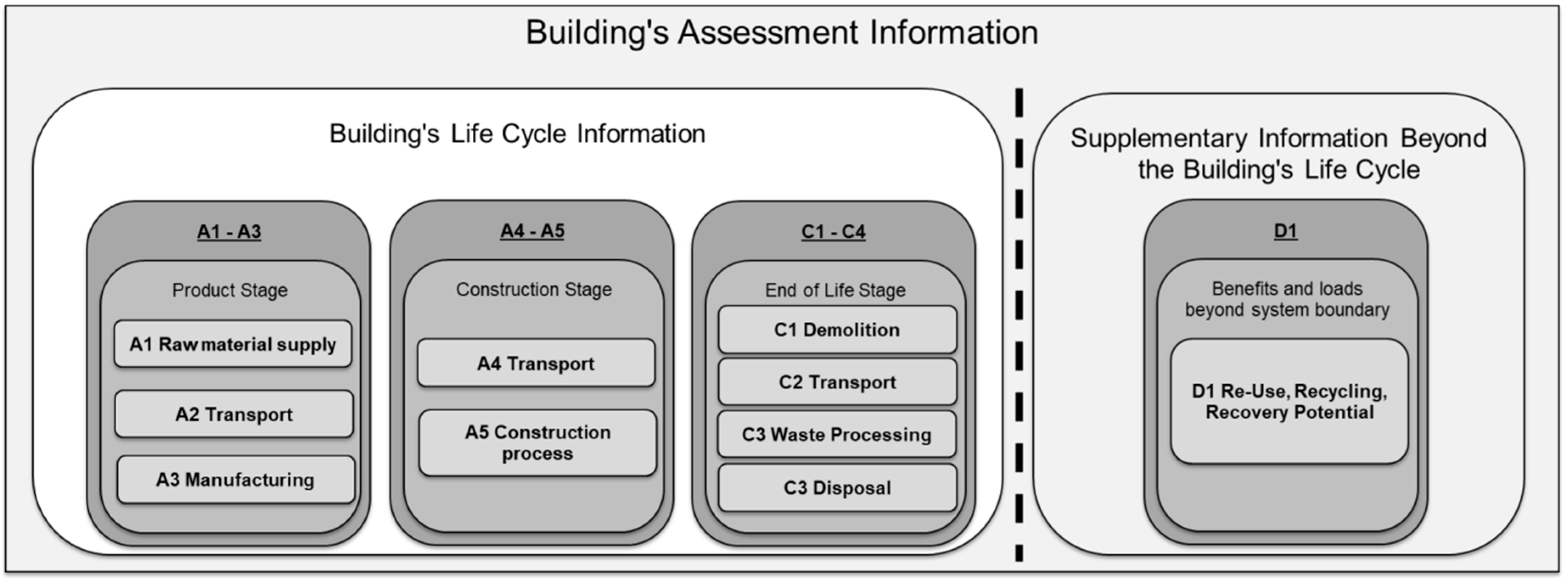
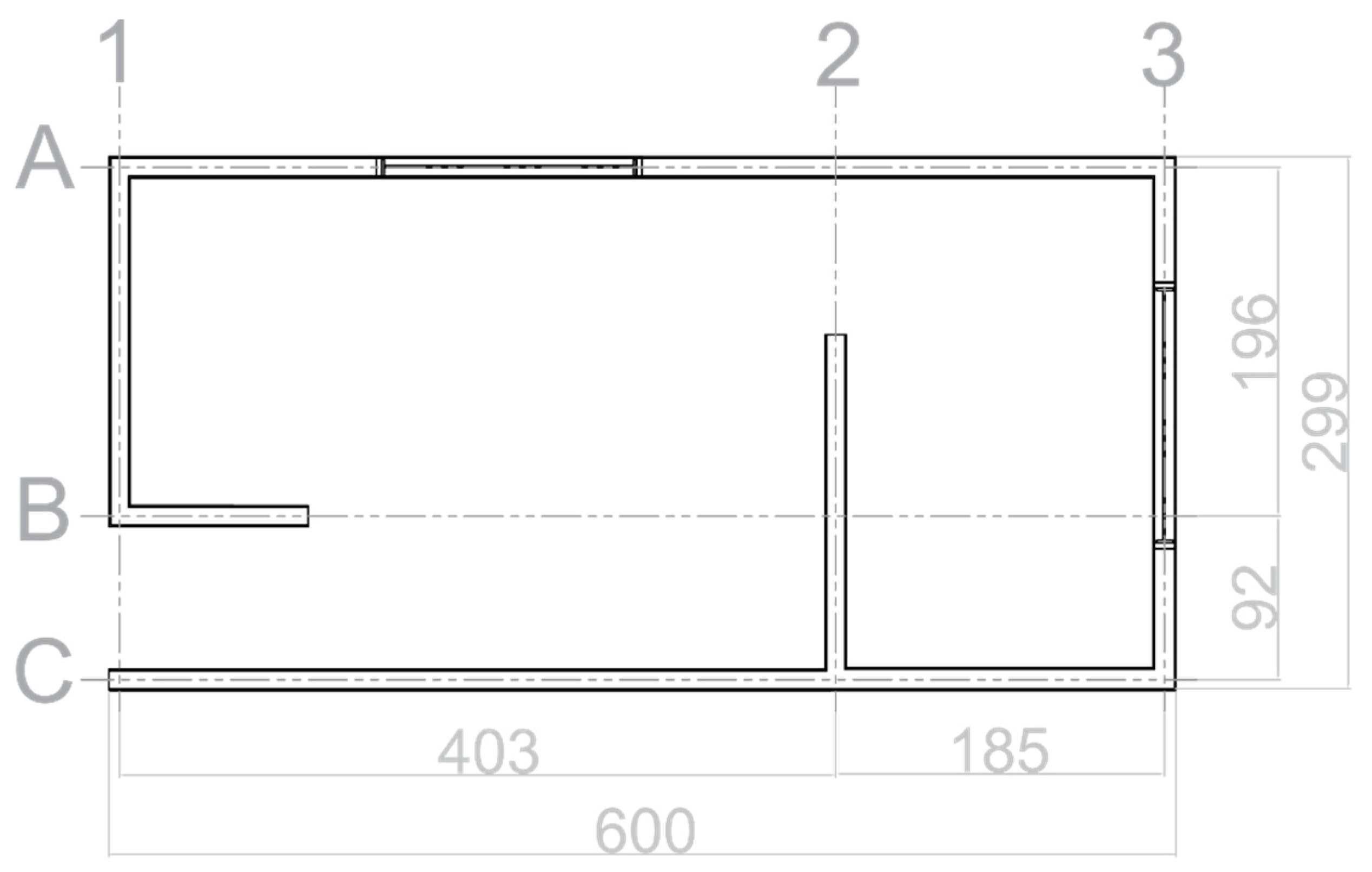
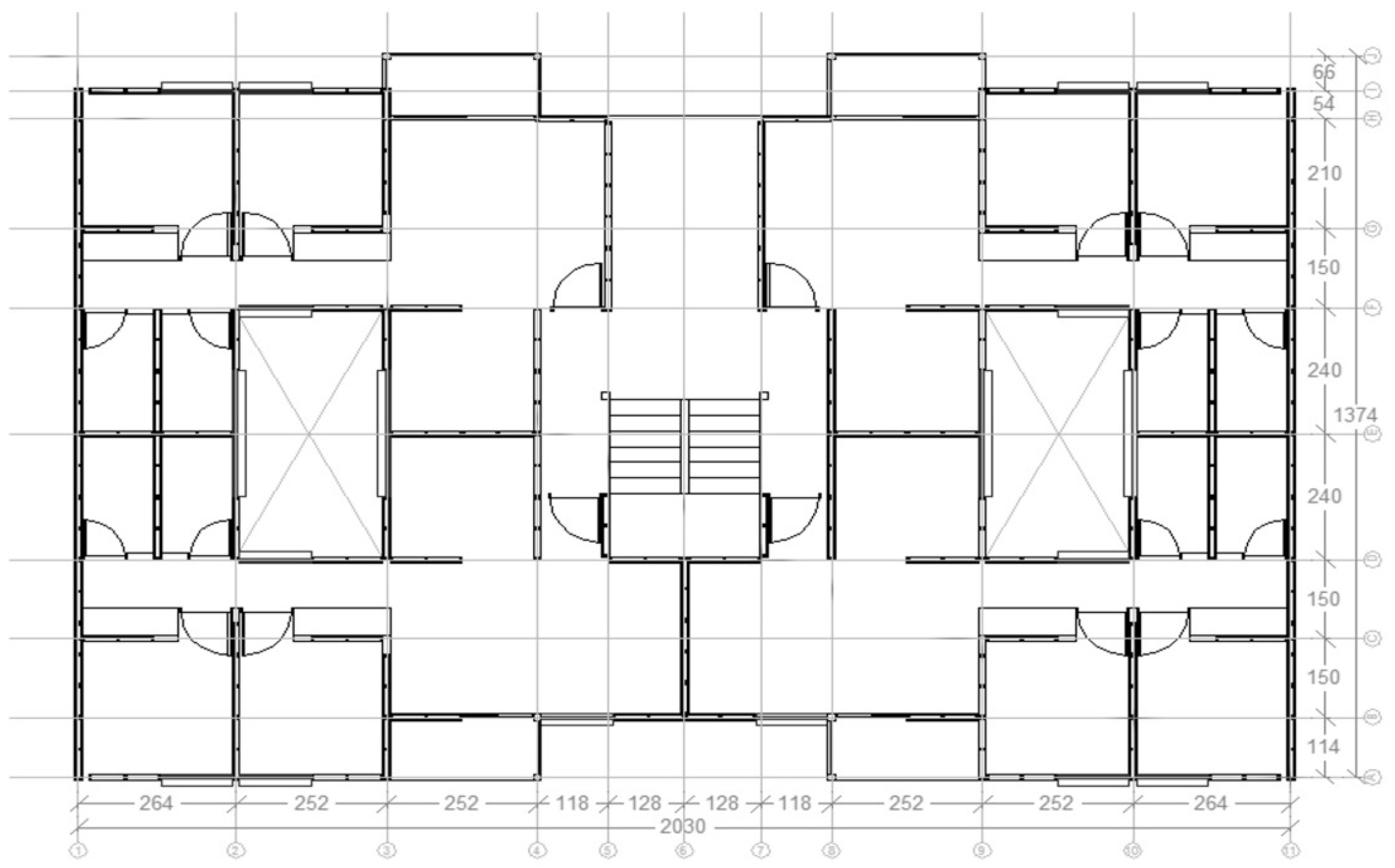
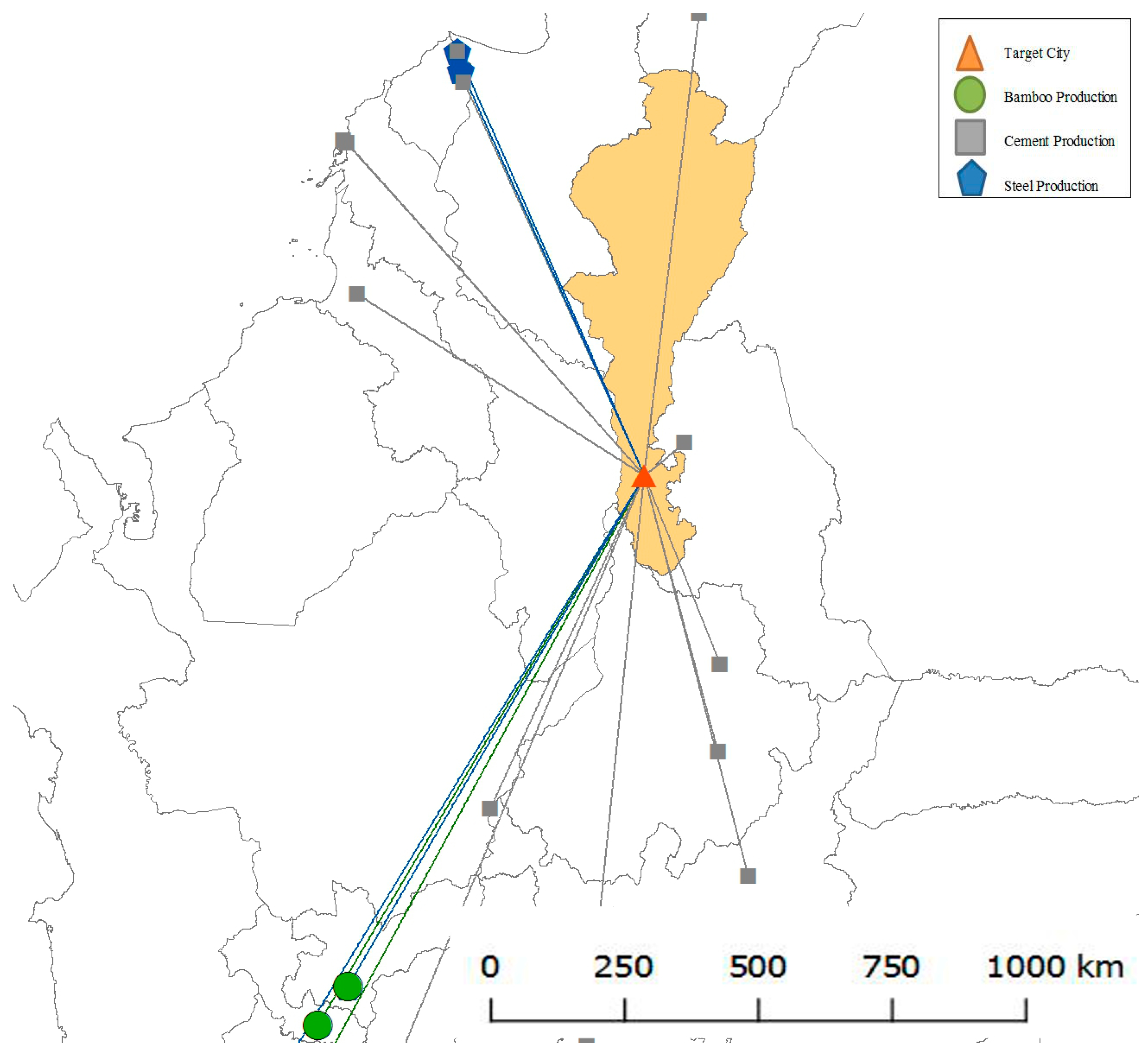
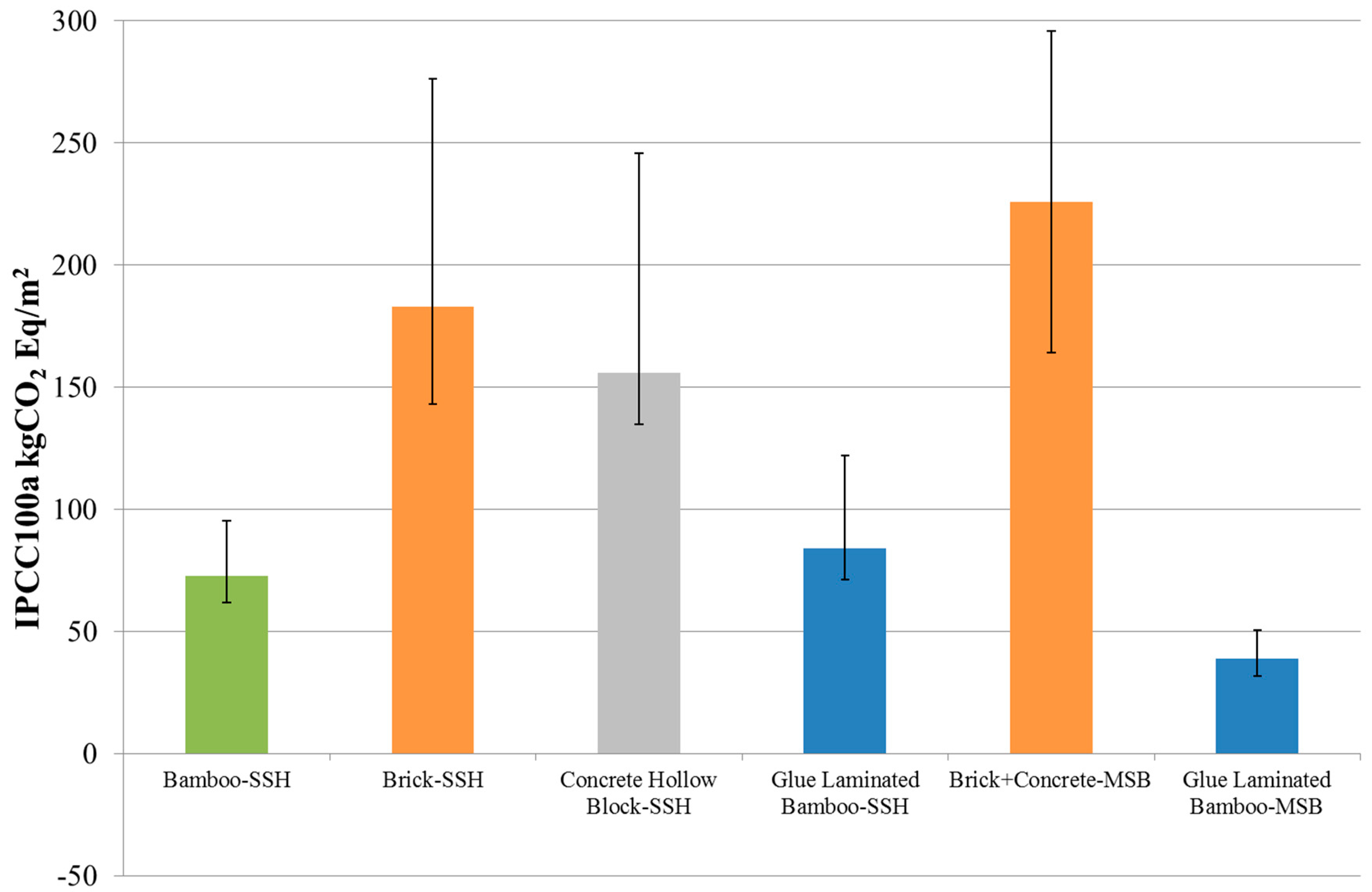
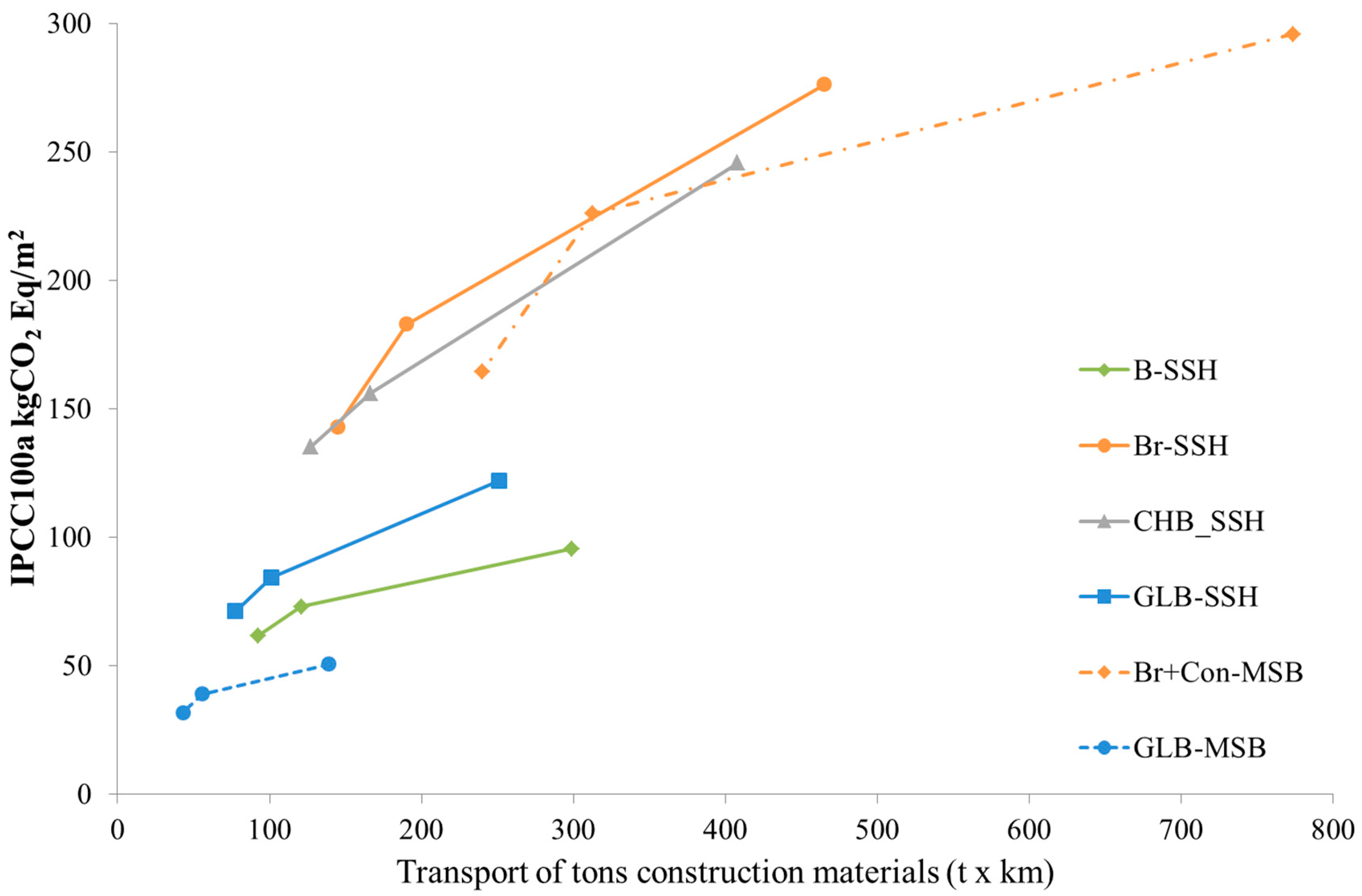
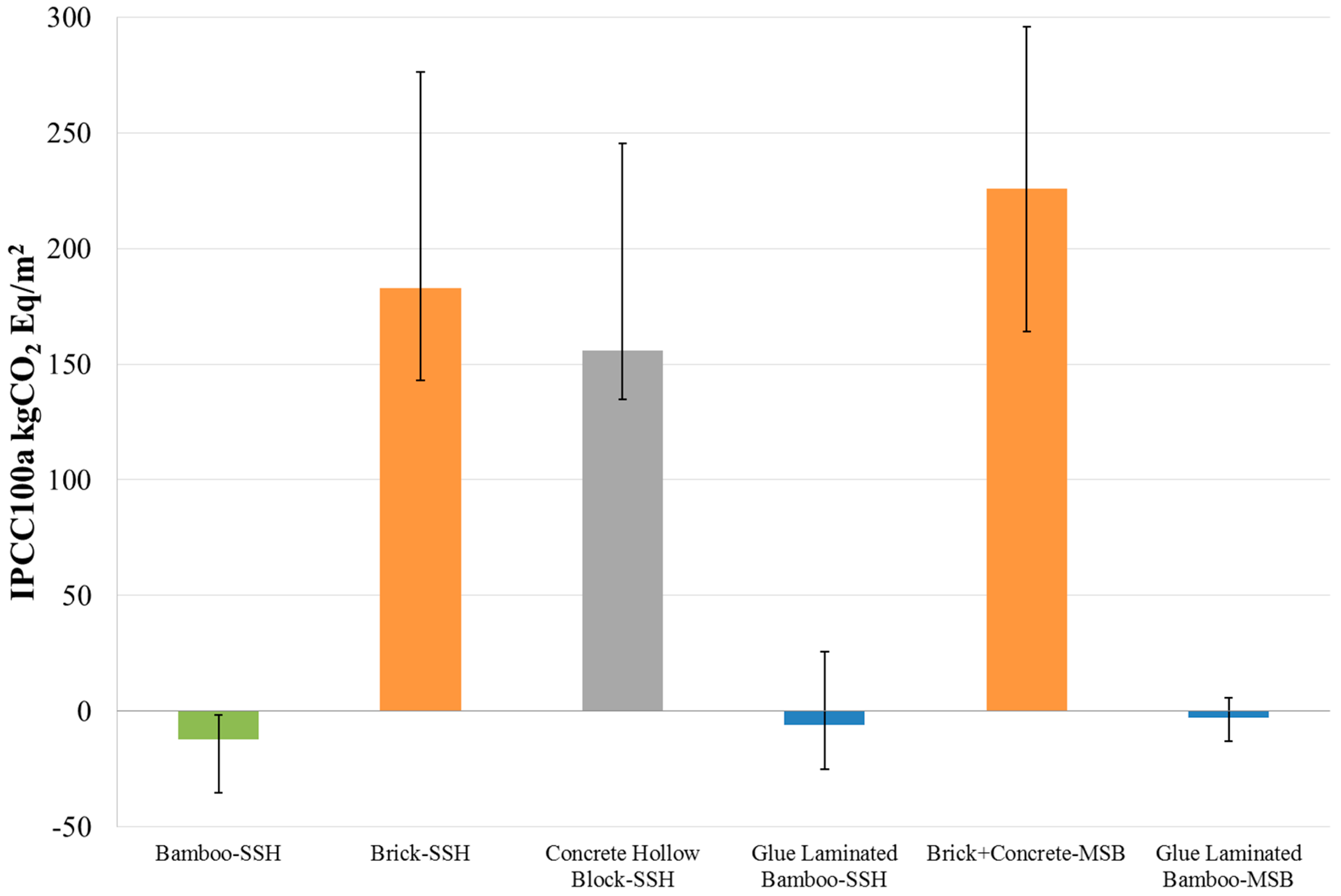
| Materials | Bamboo SSH | Brick SSH | CHB SSH | GLB SSH | Brick/Concrete MSB | GLB MSB |
|---|---|---|---|---|---|---|
| kg | kg | kg | kg | kg | kg | |
| Bamboo pole | 562 | 0 | 0 | 0 | 0 | 0 |
| Brick | 0 | 5307 | 0 | 0 | 474,000 | 0 |
| Concrete | 4332 | 4309 | 4309 | 3975 | 490,022 | 205,760 |
| Concrete hollow block (CHB) | 120 | 0 | 3816 | 0 | 0 | 0 |
| Flattened bamboo | 216 | 0 | 0 | 0 | 0 | 0 |
| Glue-laminated bamboo (GLB) | 0 | 0 | 0 | 858 | 0 | 38,341 |
| Plaster cement | 1944 | 1351 | 1351 | 437 | 120,708 | 19,530 |
| Reinforcing steel | 60 | 452 | 565 | 200 | 1682 | 0 |
| Timber | 58 | 0 | 0 | 494 | 0 | 30,180 |
| CO2 EQ | Bamboo Pole (%) | Brick (%) | Concrete Hollow Block (%) | Concrete (%) | Flattened Bamboo (%) | Glue Laminated Bamboo (%) | Steel (%) | Timber (%) | Transport (%) |
|---|---|---|---|---|---|---|---|---|---|
| Bamboo-SSH | 6.4 | 0.0 | 1.8 | 7.9 | 0.2 | 0.0 | 34.7 | 0.0 | 49.0 |
| Brick-SSH | 0.0 | 62.7 | 0.0 | 4.7 | 0.0 | 0.0 | 15.6 | 0.0 | 17.0 |
| Concrete Hollow Block-SSH | 0.0 | 0.0 | 35.9 | 8.7 | 0.0 | 0.0 | 28.9 | 0.0 | 26.5 |
| Glue Laminated Bamboo-SSH | 0.0 | 0.0 | 0.0 | 0.0 | 0.0 | 74.4 | 15.5 | 0.0 | 10.1 |
| Brick+Concrete-MSB | 0.0 | 83.6 | 0.0 | 9.3 | 0.0 | 0.0 | 0.1 | 0.0 | 7.0 |
| Glue Laminated Bamboo-MSB | 0.0 | 0.0 | 0.0 | 19.5 | 0.0 | 54.2 | 0.3 | 11.0 | 15.0 |
© 2018 by the authors. Licensee MDPI, Basel, Switzerland. This article is an open access article distributed under the terms and conditions of the Creative Commons Attribution (CC BY) license (http://creativecommons.org/licenses/by/4.0/).
Share and Cite
Zea Escamilla, E.; Habert, G.; Correal Daza, J.F.; Archilla, H.F.; Echeverry Fernández, J.S.; Trujillo, D. Industrial or Traditional Bamboo Construction? Comparative Life Cycle Assessment (LCA) of Bamboo-Based Buildings. Sustainability 2018, 10, 3096. https://doi.org/10.3390/su10093096
Zea Escamilla E, Habert G, Correal Daza JF, Archilla HF, Echeverry Fernández JS, Trujillo D. Industrial or Traditional Bamboo Construction? Comparative Life Cycle Assessment (LCA) of Bamboo-Based Buildings. Sustainability. 2018; 10(9):3096. https://doi.org/10.3390/su10093096
Chicago/Turabian StyleZea Escamilla, Edwin, Guillaume Habert, Juan Francisco Correal Daza, Hector F. Archilla, Juan Sebastian Echeverry Fernández, and David Trujillo. 2018. "Industrial or Traditional Bamboo Construction? Comparative Life Cycle Assessment (LCA) of Bamboo-Based Buildings" Sustainability 10, no. 9: 3096. https://doi.org/10.3390/su10093096
APA StyleZea Escamilla, E., Habert, G., Correal Daza, J. F., Archilla, H. F., Echeverry Fernández, J. S., & Trujillo, D. (2018). Industrial or Traditional Bamboo Construction? Comparative Life Cycle Assessment (LCA) of Bamboo-Based Buildings. Sustainability, 10(9), 3096. https://doi.org/10.3390/su10093096







